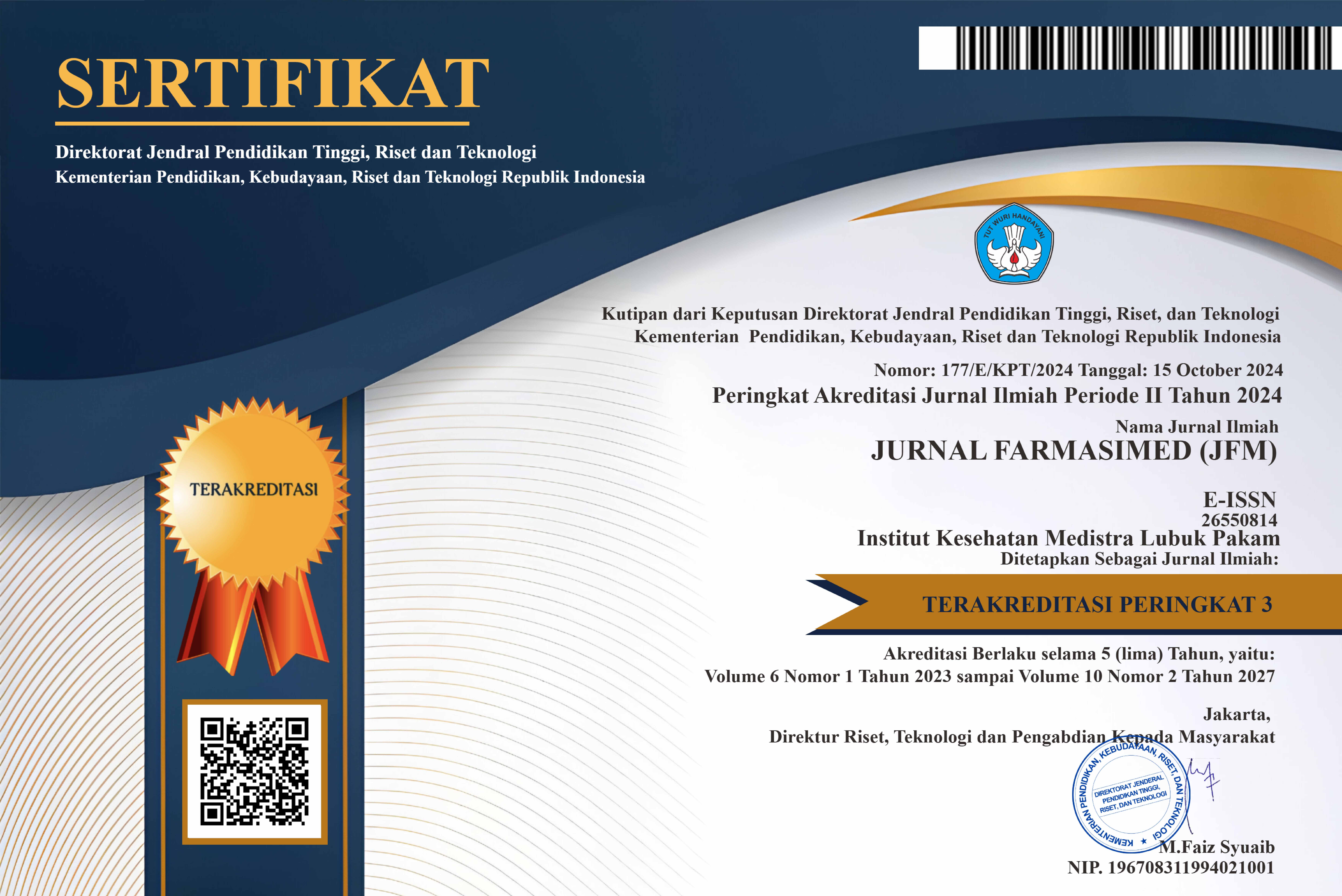Utilization of Cinnamon Leaves (Cinnamomum burmannii, Blume) and Effectiveness Test as Mouthwash against Oral Microbes
DOI:
https://doi.org/10.35451/jfm.v7i1.2287Keywords:
Cinnamomum, Dental caries, Waste, Oral microflora, MouthwashAbstract
Oral health is an important aspect to pay attention to because it is part of the digestive system. Disorders in oral health function can impact other bodily health. The use of mouthwash is necessary to improve the cleanliness and health of the mouth, especially when brushing alone is not optimal. The active compounds in mouthwash enhance cleanliness and effectively inhibit the growth of pathogenic oral microflora. Cinnamon leaves have not been widely utilized and are often left unused or discarded. Previous research has been conducted on the potential of the compounds in cinnamon leaves. This research was carried out by determining the best essential oil content of cinnamon leaves through several preliminary treatments and varying distillation times. Active compounds such as cinnamaldehyde, L-linalool, and cinnamyl acetate were found in the cinnamon leaves, making them a potential ingredient for mouthwash formulation. The aim of this study is to produce an effective mouthwash that reduces the growth of pathogenic oral microflora using underutilized local materials. The mouthwash preparation method was modified from several active ingredient mouthwash preparation methods by varying the concentration of cinnamon leaf essential oil at 5%, 10%, and 15%. The formulations were then evaluated for organoleptic properties, stability, homogeneity, and antibacterial activity against S. mutans using the disc diffusion method. The results showed that the preparations remained physically stable and homogeneous during 30 days of storage at room temperature. The cinnamon leaf mouthwash exhibited antibacterial activity against S. mutans, with average inhibition zones of 15.25 mm, 19.06 mm, and 24.34 mm for formulations I, II, and III, respectively. Based on these results, it can be concluded that the cinnamon leaf mouthwash has the potential to inhibit the growth of S. mutans bacteria."
Downloads
References
] [WHO] World Health Organization. (2022). Global Oral Health Status Report: Towards Universal Health Coverage for Oral Health by 2030. Switzerland.
[AOAC] Official Methods of Analysis. Association,Virginia: Association of Official Chemist. Inc. 2005.]
Belstrøm, D. (2020). The salivary microbiota in health and disease. Journal of Oral Microbiology, 12(1), 1723975. https://doi.org/10.1080/20002297.2020.1723975
Duarte M. (2006). Mouthwash for the Prevention and Treatment of Halitosis. World Intellectual Property Organization, Patent Cooperation
Galli, V., Venturi, M., Righetti, L., & Ferrario, M. M. (2018). Oral microbiota and probiotics: Implications for health and disease. Probiotics and Antimicrobial Proteins, 10(2), 371–380. https://doi.org/10.1007/s12602-017-9371-1
Iftari W, Fardiaz D, bachtiar BM, Wijaya CH. (2013). The Potency of Non Sucrose Cajuputc Candy in Inhibiting The Formulation of Biofilm bY Streptococcus Mutans sertotype C [Proceeding]. 13th Asean Food Conference 2013: Max Atria Singapore Expo. Singapore.
Irwanto R, Kasim A, Ismanto SD. (2022). Penentuan Kadar Minyak Atsiri Daun Kayu Manis (Cinnamomum burmannii, Blume) dengan Perlakuan Pendahuluan pada Daun. Jurnal Teknologi Pengolahan Pertanian. 4 (1):1-11.
Kemenkes RI. (2019). Laporan Nasional RISKESDAS 2018. Jakarta.
Khan, M. A., Khan, G. M., & Khan, A. (2022). Secondary Metabolites from Plants as Potential Antibacterial Agents. Journal of Medicinal Plants Research, 16(3), 129-144. https://doi.org/10.5897/JMPR2021.7265
Khasanah LU, Utami R, Ananditho BK, Nugraheni AE. (2014). Pengaruh Perlakuan Pendahuluan Fermentasi Padat dan Cair terhadap Rendemen dan Karakteristik Mutu Minyak Atsiri Daun Kayu Manis. J. Agritech. 34 (1): 36-42.
Lima, L. F. B. C., & Melnyk, M. G. (Eds.). (2021). Natural Products as Antibacterial Agents: From Traditional Medicine to Modern Drug Discovery. Springer. https://doi.org/10.1007/978-3-030-52177-2
Rachma M. (2010). Formulasi Sediaan Obat Kumur yang Mengandung Minyak Atsiri Temulawak (Curcuma xanthoriza) sebagai Antibakteri Porphyromonas gingivalis Penyebab Bau Mulut. [Skripsi]. Universitas Indonesia.
Rowe RC, Sheskey PJ, Owen SC. (2006). Handbook of Pharmaceutical Excipients, Fifth Edition. London: The Pharmaceutical Press.
Sari NWSP, Yowani SC. (2022). Literatur Review: Formulasi Obat Kumur Pencegah Infeksi Rongga Mulut Berbasis NanopartikelPerak Ekstrak Daun Keji Beling [Prosiding]. Workshop dan seminar Nasional Farmasi. 1(1):101-115.
Octora, Debi Dinha dkk (2024). Testing The Activity of Antimicrobial Cream Formulation of Ethanol Extract Of Kedondong Leaves (Spondias Dulcis) Against Bacteria Propionibacterium Acnes And Staphylococcus Aureus. Jurnal Farmasimed (JFM). Vol. 6 (173-177)
Downloads
Published
Issue
Section
License
Copyright (c) 2024 Debi Dinha Octora, Reno Irwanto, Pratiwi Christa Simarmata

This work is licensed under a Creative Commons Attribution-NoDerivatives 4.0 International License.
Copyright in each article is the property of the Author.

























